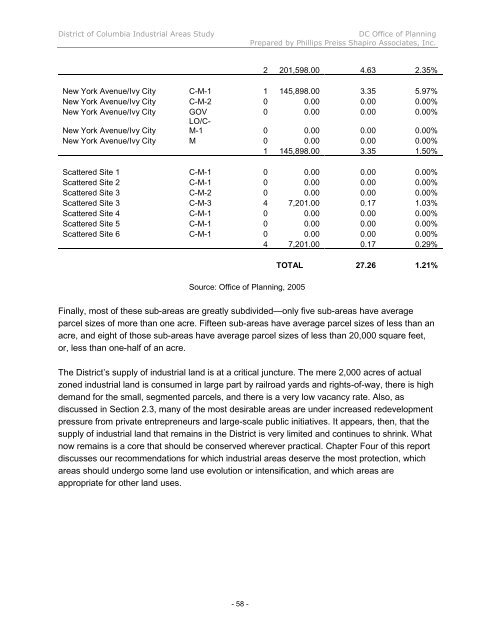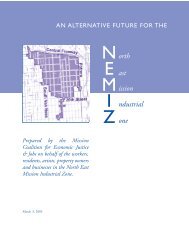INDUSTRIAL LAND IN A POST-INDUSTRIAL CITY District of ...
INDUSTRIAL LAND IN A POST-INDUSTRIAL CITY District of ...
INDUSTRIAL LAND IN A POST-INDUSTRIAL CITY District of ...
Create successful ePaper yourself
Turn your PDF publications into a flip-book with our unique Google optimized e-Paper software.
<strong>District</strong> <strong>of</strong> Columbia Industrial Areas Study DC Office <strong>of</strong> Planning<br />
Prepared by Phillips Preiss Shapiro Associates, Inc.<br />
- 58 -<br />
2 201,598.00 4.63 2.35%<br />
New York Avenue/Ivy City C-M-1 1 145,898.00 3.35 5.97%<br />
New York Avenue/Ivy City C-M-2 0 0.00 0.00 0.00%<br />
New York Avenue/Ivy City GOV<br />
LO/C-<br />
0 0.00 0.00 0.00%<br />
New York Avenue/Ivy City M-1 0 0.00 0.00 0.00%<br />
New York Avenue/Ivy City M 0 0.00 0.00 0.00%<br />
1 145,898.00 3.35 1.50%<br />
Scattered Site 1 C-M-1 0 0.00 0.00 0.00%<br />
Scattered Site 2 C-M-1 0 0.00 0.00 0.00%<br />
Scattered Site 3 C-M-2 0 0.00 0.00 0.00%<br />
Scattered Site 3 C-M-3 4 7,201.00 0.17 1.03%<br />
Scattered Site 4 C-M-1 0 0.00 0.00 0.00%<br />
Scattered Site 5 C-M-1 0 0.00 0.00 0.00%<br />
Scattered Site 6 C-M-1 0 0.00 0.00 0.00%<br />
4 7,201.00 0.17 0.29%<br />
Source: Office <strong>of</strong> Planning, 2005<br />
TOTAL 27.26 1.21%<br />
Finally, most <strong>of</strong> these sub-areas are greatly subdivided—only five sub-areas have average<br />
parcel sizes <strong>of</strong> more than one acre. Fifteen sub-areas have average parcel sizes <strong>of</strong> less than an<br />
acre, and eight <strong>of</strong> those sub-areas have average parcel sizes <strong>of</strong> less than 20,000 square feet,<br />
or, less than one-half <strong>of</strong> an acre.<br />
The <strong>District</strong>’s supply <strong>of</strong> industrial land is at a critical juncture. The mere 2,000 acres <strong>of</strong> actual<br />
zoned industrial land is consumed in large part by railroad yards and rights-<strong>of</strong>-way, there is high<br />
demand for the small, segmented parcels, and there is a very low vacancy rate. Also, as<br />
discussed in Section 2.3, many <strong>of</strong> the most desirable areas are under increased redevelopment<br />
pressure from private entrepreneurs and large-scale public initiatives. It appears, then, that the<br />
supply <strong>of</strong> industrial land that remains in the <strong>District</strong> is very limited and continues to shrink. What<br />
now remains is a core that should be conserved wherever practical. Chapter Four <strong>of</strong> this report<br />
discusses our recommendations for which industrial areas deserve the most protection, which<br />
areas should undergo some land use evolution or intensification, and which areas are<br />
appropriate for other land uses.












